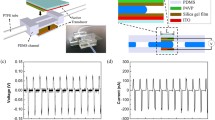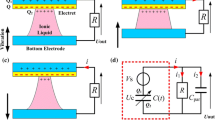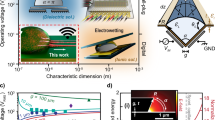Abstract
The fabrication of power generators utilized by streaming potential has been attracting profound interests for various applications such as wearable healthcare and self-powered micro/nano systems. So far, streaming potential has been generated by a charged channel wall and accumulated counter-ions. However, this approach is assumed as no-slip boundary condition, while the slippery channel wall is critical for high efficiency. Herein, we demonstrate a microfluidic power generator based on streaming potential that can be intrinsically charged at a hydrophobic channel wall. This charging mechanism has higher values of charge density and slip boundary condition. We have achieved output voltage of ~2.7 V and streaming conductance density of ~1.23 A/m2·bar with the channel that is ~2 μm high and ~3.5 μm wide. Our result is a promising step for obtaining low-cost, high efficient power-generators for micro/nano systems.
Similar content being viewed by others
Abbreviations
- PG:
-
Power-Generator
- EDL:
-
Electric double layer
- DI:
-
Deionized
- PDMS:
-
Polydimethylsiloxane
- MEMS:
-
Microelectromechanical systems
- RIE:
-
Reactive ion etching
- C4F8 :
-
Octafluorocyclobutane
- VSFG:
-
Vibrational sum-frequency generation
- MD:
-
Molecular dynamics
References
Zhong, J., Zhong, Q., Chen, G., Hu, B., Zhao, S., et al., “Surface Charge Self-Recovering Electret Film for Wearable Energy Conversion in a Harsh Environment,” Energy & Environmental Science, Vol. 9, No. 10, pp. 3085–3091, 2016.
Wang, Z. L. and Song, J., “Piezoelectric Nanogenerators Based on Zinc Oxide Nanowire Arrays,” Science, Vol. 312, No. 5771, pp. 242–246, 2006.
Kim, J. E., Kim, H., Yoon, H., Kim, Y. Y., and Youn, B. D., “An Energy Conversion Model for Cantilevered Piezoelectric Vibration Energy Harvesters Using Only Measurable Parameters,” Int. J. Precis. Eng. Manuf.-Green Tech., Vol. 2, No. 1, pp. 51–57, 2015.
Bae, J., Lee, J., Kim, S., Ha, J., Lee, B.-S., et al., “Flutter-Driven Triboelectrification for Harvesting Wind Energy,” Nature Communications, Vol. 5, Article No. 4929, 2014.
Zi, Y., Wang, J., Wang, S., Li, S., Wen, Z., et al., “Effective Energy Storage from a Triboelectric Nanogenerator,” Nature Communications, Vol. 7, Article No. 10987, 2016.
Yang, Y., Jung, J. H., Yun, B. K., Zhang, F., Pradel, K. C., et al., “Flexible Pyroelectric Nanogenerators Using a Composite Structure of Lead-Free KNbO3 Nanowires,” Advanced Materials, Vol. 24, No. 39, pp. 5357–5362, 2012.
Nguyen, H., Navid, A., and Pilon, L., “Pyroelectric Energy Converter Using Co-Polymer P (VDF-TrFE) and Olsen Cycle for Waste Heat Energy Harvesting,” Applied Thermal Engineering, Vol. 30, No. 14, pp. 2127–2137, 2010.
Siria, A., Poncharal, P., Biance, A.-L., Fulcrand, R., Blase, X., et al., “Giant Osmotic Energy Conversion Measured in a Single Transmembrane Boron Nitride Nanotube,” Nature, Vol. 494, No. 7438, pp. 455–458, 2013.
Guo, W., Cheng, C., Wu, Y., Jiang, Y., Gao, J., et al., “Bio-Inspired Two-Dimensional Nanofluidic Generators Based on a Layered Graphene Hydrogel Membrane,” Advanced Materials, Vol. 25, No. 42, pp. 6064–6068, 2013.
Haldrup, S., Catalano, J., Hansen, M. R., Wagner, M., Jensen, G. V., et al., “High Electrokinetic Energy Conversion Efficiency in Charged Nanoporous Nitrocellulose/Sulfonated Polystyrene Membranes,” Nano Letters, Vol. 15, No. 2, pp. 1158–1165, 2015.
Chun, M.-S., Lee, T. S., and Choi, N. W., “Microfluidic Analysis of Electrokinetic Streaming Potential Induced by Microflows of Monovalent Electrolyte Solution,” Journal of Micromechanics and Microengineering, Vol. 15, No. 4, pp. 710–719, 2005.
Chun, M.-S., Shim, M. S., and Choi, N. W., “Fabrication and Validation of a Multi-Channel Type Microfluidic Chip for Electrokinetic Streaming Potential Devices,” Lab on a Chip, Vol. 6, No. 2, pp. 302–309, 2006.
Van der Heyden, F. H., Bonthuis, D. J., Stein, D., Meyer, C., and Dekker, C., “Electrokinetic Energy Conversion Efficiency in Nanofluidic Channels,” Nano Letters, Vol. 6, No. 10, pp. 2232–2237, 2006.
Van Der Heyden, F. H., Bonthuis, D. J., Stein, D., Meyer, C., and Dekker, C., “Power Generation by Pressure-Driven Transport of Ions in Nanofluidic Channels,” Nano Letters, Vol. 7, No. 4, pp. 1022–1025, 2007.
Van Der Heyden, F. H., Stein, D., and Dekker, C., “Streaming Currents in a Single Nanofluidic Channel,” Physical Review Letters, Vol. 95, No. 11, Paper No. 116104, 2005.
Koltonow, A. R. and Huang, J., “Two-Dimensional Nanofluidics,” Science, Vol. 351, No. 6280, pp. 1395–1396, 2016.
Zaytseva, N. V., Goral, V. N., Montagna, R. A., and Baeumner, A. J., “Development of a Microfluidic Biosensor Module for Pathogen Detection,” Lab on a Chip, Vol. 5, No. 8, pp. 805–811, 2005.
Kurita, R., Hayashi, K., Fan, X., Yamamoto, K., Kato, T., et al., “Microfluidic Device Integrated with Pre-Reactor and Dual Enzyme-Modified Microelectrodes for Monitoring in Vivo Glucose and Lactate,” Sensors and Actuators B: Chemical, Vol. 87, No. 2, pp. 296–303, 2002.
Kim, H. J., Jang, W. K., Kim, B. H., and Seo, Y. H., “Advancing Liquid Front Shape Control in Capillary Filling of Microchannel via Arrangement of Microposts for Microfluidic Biomedical Sensors,” Int. J. Precis. Eng. Manuf., Vol. 17, No. 1, pp. 59–63, 2016.
Yager, P., Edwards, T., Fu, E., Helton, K., Nelson, K., et al., “Microfluidic Diagnostic Technologies for Global Public Health,” Nature, Vol. 442, No. 7101, pp. 412–418, 2006.
Sun, Y. and Kwok, Y. C., “Polymeric Microfluidic System for DNA Analysis,” Analytica Chimica Acta, Vol. 556, No. 1, pp. 80–96, 2006.
Lin, C.-H., Ferguson, G. S., and Chaudhury, M. K., “Electrokinetics of Polar Liquids in Contact with Nonpolar Surfaces,” Langmuir, Vol. 29, No. 25, pp. 7793–7801, 2013.
Yang, J. and Kwok, D. Y., “Microfluid Flow in Circular Microchannel with Electrokinetic Effect and Navier’s Slip Condition,” Langmuir, Vol. 19, No. 4, pp. 1047–1053, 2003.
Ren, Y. and Stein, D., “Slip-Enhanced Electrokinetic Energy Conversion in Nanofluidic Channels,” Nanotechnology, Vol. 19, No. 19, Paper No. 195707, 2008.
Tandon, V., Bhagavatula, S. K., Nelson, W. C., and Kirby, B. J., “Zeta Potential and Electroosmotic Mobility in Microfluidic Devices Fabricated from Hydrophobic Polymers: 1. The Origins of Charge,” Electrophoresis, Vol. 29, No. 5, pp. 1092–1101, 2008.
Vacha, R., Marsalek, O., Willard, A. P., Bonthuis, D. J., Netz, R. R., et al., “Charge Transfer between Water Molecules as the Possible Origin of the Observed Charging at the Surface of Pure Water,” The Journal of Physical Chemistry Letters, Vol. 3, No. 1, pp. 107–111, 2011.
Tian, C. and Shen, Y., “Structure and Charging of Hydrophobic Material/Water Interfaces Studied by Phase-Sensitive Sum-Frequency Vibrational Spectroscopy,” Proceedings of the National Academy of Sciences, Vol. 106, No. 36, pp. 15148–15153, 2009.
Creux, P., Lachaise, J., Graciaa, A., and Beattie, J. K., “Specific Cation Effects at the Hydroxide-Charged Air/Water Interface,” The Journal of Physical Chemistry C, Vol. 111, No. 9, pp. 3753–3755, 2007.
Strazdaite, S., Versluis, J., and Bakker, H. J., “Water Orientation at Hydrophobic Interfaces,” The Journal of Chemical Physics, Vol. 143, No. 8, Paper No. 084708, 2015.
Vácha, R., Rick, S. W., Jungwirth, P., de Beer, A. G., de Aguiar, H. B., et al., “The Orientation and Charge of Water at the Hydrophobic Oil Droplet–Water Interface,” Journal of the American Chemical Society, Vol. 133, No. 26, pp. 10204–10210, 2011.
Joseph, P. and Tabeling, P., “Direct Measurement of the Apparent Slip Length,” Physical Review E, Vol. 71, No. 3, Paper No. 035303, 2005.
K Water, www.k-water.or.kr (Accessed 25 OCT 2017)
Author information
Authors and Affiliations
Corresponding author
Rights and permissions
About this article
Cite this article
Choi, Y.W., Jang, S., Chun, MS. et al. Efficient Microfluidic Power Generator Based on Interaction between DI Water and Hydrophobic-Channel Surface. Int. J. of Precis. Eng. and Manuf.-Green Tech. 5, 255–260 (2018). https://doi.org/10.1007/s40684-018-0026-5
Received:
Revised:
Accepted:
Published:
Issue Date:
DOI: https://doi.org/10.1007/s40684-018-0026-5




